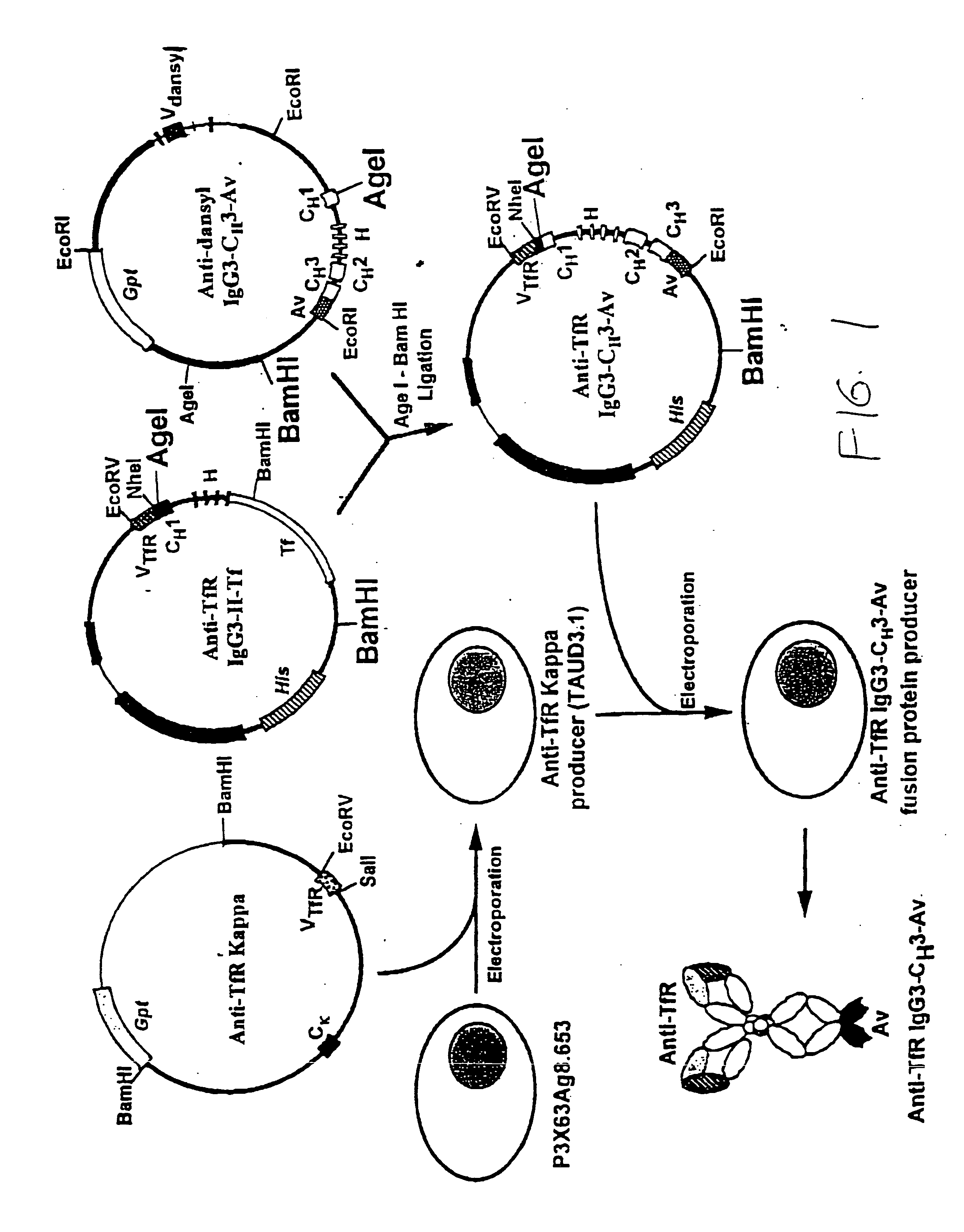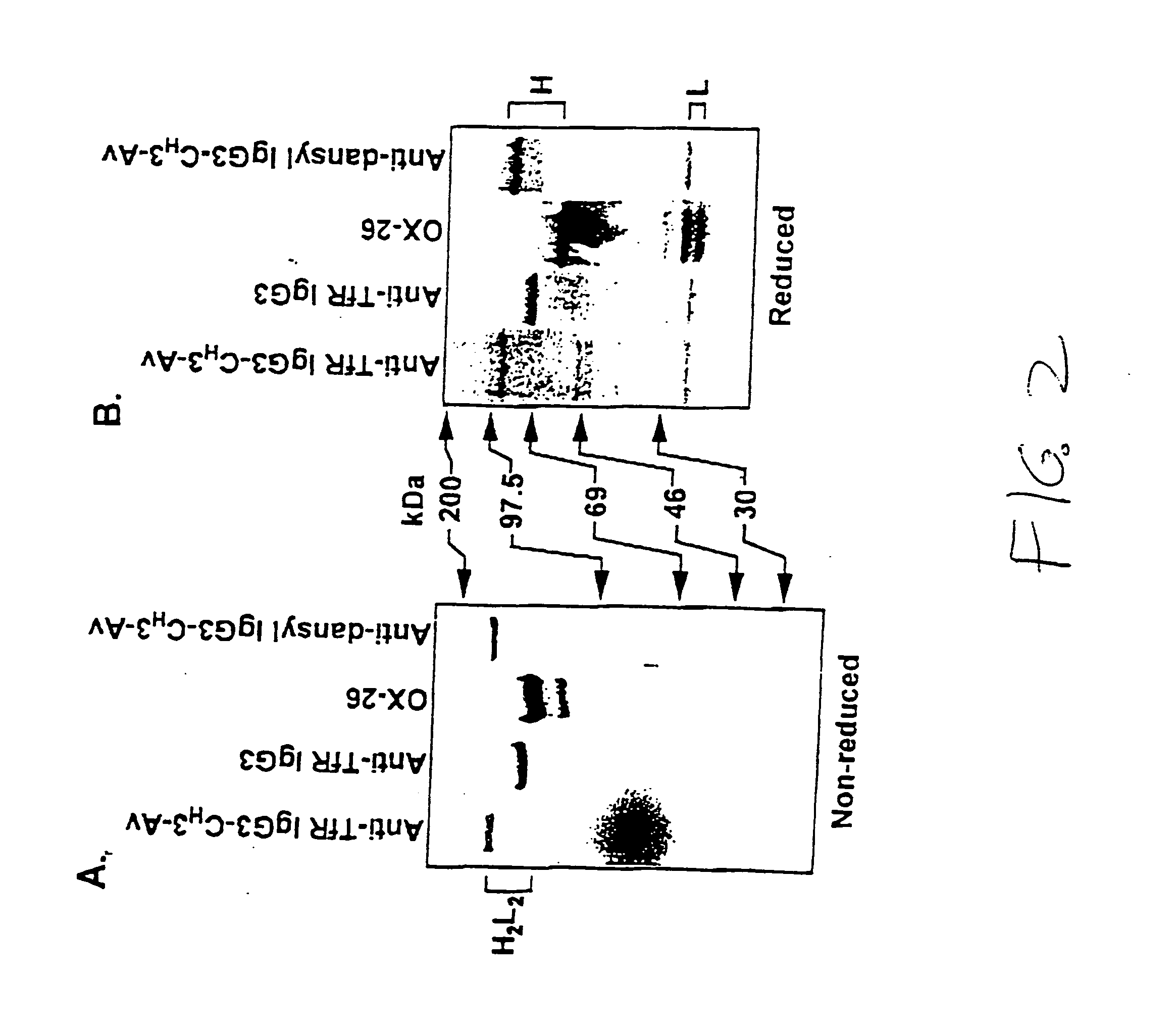Anti-growth factor receptor avidin fusion proteins as universal vectors for drug delivery
a technology of anti-growth factor receptor and fusion proteins, which is applied in the direction of immunoglobulins, peptides, drugs against animals/humans, etc., can solve the problems of limited clinical utility of many proteins of therapeutic interest in the brain, decrease or loss of activity of one or both covalently conjugated partners, and difficulty in producing reproducible, homogeneous products. to achieve the effect of determining the cytotoxicity of a compound
- Summary
- Abstract
- Description
- Claims
- Application Information
AI Technical Summary
Benefits of technology
Problems solved by technology
Method used
Image
Examples
example 2
Use of Antibody Construct of Example 1 to Deliver Antisense Peptide Nucleic Acid to Brain
[0219] The antibody construct of Example 1 was used to deliver an 18-mer peptide nucleic acid with biotin at its 5′-end and lysine and tyrosine at its 3′-end to brain as a model for the treatment of HIV in brain. This peptide nucleic acid is an antisense peptide nucleic acid for the rev gene of HIV-1.
[0220] Efficient and specific targeting of an active agent to the desired site is a critical factor for the successful diagnosis and / or therapy of many diseases. One region of the body particularly difficult to target is the brain due to the presence of the high resistance blood-brain barrier (BBB) formed by tightly joined capillary endothelial cell membranes (1-5). The BBB effectively restricts transport from the blood of certain molecules, especially those that are water soluble and larger than several hundred daltons (6). In fact the clinical utility of many proteins of therapeutic interest for...
example 3
Use of Antibody Construct of Example 1 to Deliver β-Galactosidase and the Gene Encoding β-Galactosidase into TfR Bearing Cells
[0274] To demonstrate that anti-TfR IgG3-CH3-Av can be used as a universal vector to deliver biotinylated compound into cancer cells that overexpress the TfR w we first studied the ability of anti-TfR IgG3-CH3-Av to target the TfR overexpressed on the surface of cancer cells such as the rat myeloma cell line Y3-Ag1.2.3. FIG. 6 shows flow cytometry demonstrating the specificity of anti-rat TfR IgG3-CH3-Av for TfR: 5×105 rat Y3-Ag1.2.3 cells were incubated with either 1 μg of control anti-DNS IgG3-CH3-Av (panel A) or an anti-rat TfR IgG3-CH3-Av (panel B) for 1 h at 4° C. Then the cells were washed and incubated 1 h at 4° C. with PE-labeled goat anti-human IgG (Pharmingen, San Diego, Calif.) and analyzed by flow cytometry. Analysis was performed with a FACScan (Becton-Dickinson, Mountain View, Calif.) equipped with a blue laser excitation of 15 mW at 488 nm.
[0...
PUM
| Property | Measurement | Unit |
|---|---|---|
| mean residence time | aaaaa | aaaaa |
| half life | aaaaa | aaaaa |
| volume | aaaaa | aaaaa |
Abstract
Description
Claims
Application Information
 Login to View More
Login to View More - R&D
- Intellectual Property
- Life Sciences
- Materials
- Tech Scout
- Unparalleled Data Quality
- Higher Quality Content
- 60% Fewer Hallucinations
Browse by: Latest US Patents, China's latest patents, Technical Efficacy Thesaurus, Application Domain, Technology Topic, Popular Technical Reports.
© 2025 PatSnap. All rights reserved.Legal|Privacy policy|Modern Slavery Act Transparency Statement|Sitemap|About US| Contact US: help@patsnap.com



